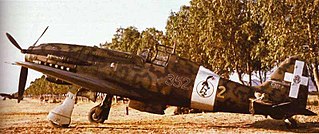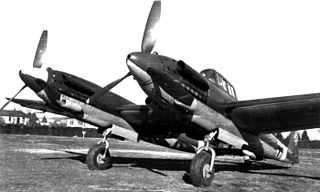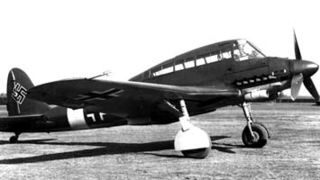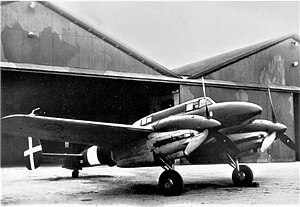
The Macchi C.205Veltro was an Italian World War II fighter aircraft built by the Aeronautica Macchi. Along with the Reggiane Re.2005 and Fiat G.55, the Macchi C.205 was one of the three "Serie 5" Italian fighters built around the powerful Daimler-Benz DB 605 engine. The C.205 was a development of the earlier C.202 Folgore. With a top speed of some 640 km/h (400 mph) and equipped with a pair of 20 mm cannon as well as 12.7 mm Breda machine guns, the Macchi C.205 Veltro was highly respected by Allied and Axis pilots alike. Widely regarded as one of the best Italian aircraft of World War II, it proved to be extremely effective, destroying a large number of Allied bombers. The Macchi C. 205 proved capable of meeting fighters such as the North American P-51D Mustang on equal terms, which encouraged the Luftwaffe to use a number of these aircraft to equip one Gruppe.

The Messerschmitt Bf 110, often known unofficially as the Me 110, is a twin-engine Zerstörer, fighter-bomber, and night fighter (Nachtjäger) developed in Nazi Germany in the 1930s and used by the Luftwaffe during World War II. Hermann Göring was a proponent of the Bf 110, believing its heavy armament, speed, and range would make the Bf 110 the Luftwaffe’s premier offensive fighter. Early variants were armed with two MG FF 20 mm cannon, four 7.92 mm MG 17 machine guns, and one 7.92 mm MG 15 machine gun for defence. Development work on an improved type to replace the Bf 110 - the Messerschmitt Me 210 - began before the war started, but its teething troubles resulted in the Bf 110 soldiering on until the end of the war in various roles. Its intended replacements, the aforementioned Me 210 and the significantly improved Me 410 Hornisse, never fully replaced the Bf 110.

The Focke-Wulf Fw 191 was a prototype German bomber of World War II, as the Focke-Wulf firm's entry for the Bomber B advanced medium bomber design competition. Two versions were intended to be produced, a twin-engine version using the Junkers Jumo 222 engine and a four-engine variant which was to have used the smaller Daimler-Benz DB 605 engine. The project was eventually abandoned due to technical difficulties with the engines.

The Fiat G.55 Centauro was a single-engine single-seat World War II fighter aircraft used by the Regia Aeronautica and the Aeronautica Nazionale Repubblicana in 1943–1945. It was designed and built in Turin by Fiat. The Fiat G.55 was arguably the best type produced in Italy during World War II, but it did not enter production until 1943, when, after comparative tests against the Messerschmitt Bf 109G and the Focke-Wulf 190, the Luftwaffe itself regarded the Fiat G.55 as "the best Axis fighter".
Breda-SAFAT was an Italian weapons manufacturer of the 1930s and 1940s that designed and produced a range of machine-guns and cannon primarily for use in aircraft. Based on the M1919 Browning machine gun, the Italian guns were chambered to fire indigenous ammunition with 7.7 mm (0.303 in) and 12.7 mm (0.500 in) calibres, predominantly ball, tracer for the 7.7mm, including high explosive incendiary tracer (HEI-T), or armour-piercing (AP) for the 12.7mm.
The Messerschmitt Me 265 was a design project for a Zerstörer, produced by leading German aircraft manufacturer Messerschmitt in World War II.

The Reggiane Re.2002 Ariete ("Ram") was an Italian fighter-bomber developed during World War II. The aircraft was a further development of the Re.2000, with some of the modifications that already had been introduced in the Re.2001. The aircraft was mainly used by the Regia Aeronautica, but it also saw limited use with the German Luftwaffe, who used it against the French resistance.
The Savoia-Marchetti SM.88, was an Italian twin-engined, three-seat, heavy fighter prototype of World War II, featuring a twin-boom structure, and powered by German Daimler-Benz DB 601 engines.

The Savoia-Marchetti SM.91 was a two-seat, twin-engined, Italian heavy fighter prototype, designed to compete in a 1942 revision to a long-range fighter-bomber contract offered by the Regia Aeronautica to Italian aircraft companies in 1938. The original 1938 specification yielded the Savoia-Marchetti SM.88, which the SM.91 was largely based on.

The Savoia-Marchetti SM.92 was an Italian heavy fighter/bomber of World War II based on the Savoia-Marchetti SM.88. The SM.92 did away with the mid-wing crew nacelle. The crew of two sat in the left fuselage only. Two DB 605 engines were fitted.

The Savoia-Marchetti SM.93 was an Italian dive bomber designed and produced in Italy from 1943.

The Breda Ba.201 was an Italian dive bomber designed during World War II, that never entered production.

The Piaggio P.119 was an Italian experimental fighter of World War II. It had a relatively novel layout, with a "buried" radial engine mounted mid-fuselage. Only a single prototype was built before the Armistice between Italy and the allied armed forces, which ended the project.

The IMAM Ro.57 was an Italian twin-engined, single-seat monoplane fighter of the Regia Aeronautica. Based on a 1939 design by Giovanni Galasso the aircraft did not enter production until 1943.

The Caproni Ca.355 Tuffo was a low-wing single-engine dive bomber, designed and built by the Italian Caproni company in 1941, which never proceeded beyond a single prototype. Derived from Ca.335 Mistral, the Ca.355 was proposed to equip the Regia Aeronautica, but it was found to offer little advantage over the German Junkers Ju 87 "Stuka" and the project was abandoned.

The Caproni Vizzola F.4 was an Italian fighter aircraft prototype that was designed in 1937 and built from 1939. It was a single-seat, low-wing cantilever monoplane with retractable landing gear.

The Caproni Vizzola F.6 was a World War II-era Italian fighter aircraft built by Caproni. It was a single-seat, low-wing cantilever monoplane with retractable landing gear. Only two prototypes were built, one designated F.6M and the other designated F.6Z.

The Caproni Ca.331 Raffica was an Italian aircraft built by Caproni in the early 1940s as a tactical reconnaissance aircraft/light bomber and also as a night fighter.

The CANSA FC.20 was a twin engine reconnaissance bomber/ground attack monoplane designed and built in Italy in 1941. Several versions with different armament and engines were flown but only the FC.20bis ground attack variant reached squadron service, in very small numbers, before the 1943 armistice.

The Isotta Fraschini Zeta was an air cooled X engine with 24 cylinders developed by the Italian engineering company Isotta Fraschini in the 1940s. It was developed as an indigenous alternative to the imported Daimler-Benz DB 605 that was being built under licence as the Fiat RA.1050 R.C.58 Tifone. The engine was essentially two Gamma V12 engines on a single crankshaft, but proved troublesome to develop and never entered production.

















